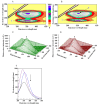Molecular Profiling and FTIR Characterization of Wheat Germ Oil, Supported by the Screening of Its Anti-Inflammatory and Cytotoxic Properties
- PMID: 40305174
- PMCID: PMC12025205
- DOI: 10.3390/biom15040464
Molecular Profiling and FTIR Characterization of Wheat Germ Oil, Supported by the Screening of Its Anti-Inflammatory and Cytotoxic Properties
Abstract
Wheat germ oil (WGO), derived from the nutrient-dense germ of wheat kernels, is a functional bioactive product, known for its rich composition of essential fatty acids, sterols, tocopherols, and polyphenols. This study aimed to comprehensively profile the molecular and therapeutic properties of WGO, focusing on its antioxidant, cytotoxic, and anti-inflammatory activity. Using advanced analytical techniques such as gas chromatography-mass spectrometry (GC-MS), Fourier Transform Infrared (FTIR) spectroscopy, and fluorescence analysis, WGO was shown to contain high levels of linoleic acid (45.3%), squalene (2.52 g/100 g), and polyphenols. WGO displayed selective cytotoxicity, inhibiting cancer cells' viability in melanoma, prostate, and colorectal cancer cell lines, but not normal cells, highlighting its chemoprevention potential. Furthermore, WGO significantly reduced LPS-induced nitric oxide and IL-6 production in macrophages, with effects plateauing at higher doses. The 3D fluorescence spectra showed a significant decrease in fluorescence intensity when human serum albumin interacted with the WGO polyphenol fraction, indicating a strong binding affinity and stable complex formation. These findings emphasize the nutritional and therapeutic potential of WGO as a natural bioactive agent, warranting further mechanistic investigation and broader applications in health and disease management.
Keywords: FTIR; anti-inflammatory effect; cytotoxic potential; fatty acids; human protein binding; squalene; wheat germ oil.
Conflict of interest statement
The authors declare no conflicts of interest.
Figures




References
-
- Yuldasheva N.K., Ul’chenko N.T., Glushenkova A.I. Wheat germ oil. Chem. Nat. Compd. 2010;46:97–98.
-
- Niu L.Y., Jiang S.T., Pan L.J., Pang M. Characterization of wheat germ oil in terms of volatile compounds, lipid composition, thermal behavior, and structure. Int. J. Food Prop. 2013;16:1740–1749. doi: 10.1080/10942912.2011.608141. - DOI
-
- Barnes P.J. Lipid composition of wheat germ and wheat germ oil. Fette Seifen Anstrichm. 1982;84:256–269.
MeSH terms
Substances
LinkOut - more resources
Full Text Sources
Miscellaneous

